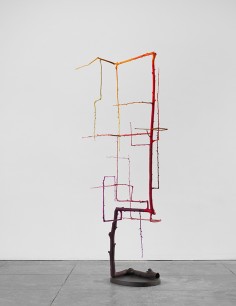evan holloway
エヴァン·ホロウェイ
埃文·霍洛威
source: artnewsorg
Evan Holloway’s sculptures pit the world of physical objects against the immaterial world of human perception, collective understanding and culturally obtained information. The LA-based artist’s works engage with human cognition and its encounter with the object, contemplating what the object would otherwise be without this transaction.
The sculptures are assembled with an underpinning interest in drawing and combine formal rigor with an irreverent and playful use of materials. They simultaneously encompass formalism and figuration and blend simple craft-like media with more traditional components, questioning and celebrating modern sculptural history all at once. Sturdy constructions using steel and concrete are employed alongside delicate assemblages and balancing acts and comparatively frail materials such as twigs. The susceptibility of the exposed fragile elements to movement and to the environment around them implies the same instability that exists in the makeshift nature of ‘understanding’ the physical object.
Holloway mischievously redesigns the descriptive purpose of objects, turning the viewer’s familiar associations with them askew. Figurative elements such as tyres, faces and trees are used as building blocks in the formal construction of a whole new ‘system’ of meaning. The ‘system’ determines the form of the sculpture, so that the sculpture ends up as an embodiment of it. These different systems are also not ‘natural’: they are based on cultural information and depend on human perception to give them meaning.
’51 – 55’ is part of an ongoing series that will end at 100. Each steel number has a corresponding amount of heads hanging from it. The piece exercises three uses of numbers: cardinal (the amount of heads), ordinal (the sculpture is part of a sequential project) and nominal (the title of the piece). As a sculpture, its form is somewhat variable: the heads are able to move about freely, and do so in a breeze or with vibrations from viewers walking around it in the space. It is simultaneously an abstract sculpture, a figurative sculpture and an indexical sculpture referring to its own production. Whilst the individual faces within the mass of other faces have the possibility of engaging on an ideological level, the sculpture is committed to the potential formal relationships of parts to a whole, and to the sense of the collective (just as cultural data and perception are collective). The individual faces within the sculptures refer back to their relationships within the broader communities of faces they exist in, just as Holloway’s ‘number’ sculptures refer to the wider project that they are part of.
In “Relative Frequency”, the letters of the alphabet stencilled around the tyre inner tube are connected to sections on the concrete rod that designate their frequency of use in the English alphabet. ‘E’ (the most commonly used letter) connects its chain to the largest section at the top of the rod. ‘T’, the second most used letter, connects to the second largest section, and so on. Holloway interconnects different sequences and makes a corporeal model of the abstract relationship in our brains between the two groupings; we know the alphabetical sequence, and we use letters in this frequency.
The third sculpture in the show is formed from a real tree branch, its spontaneous multidirectional growth disrupted and coerced into an artificial distribution. The branch is sawn and re-arranged with its joints re-set into 90 degree angles, and then painted over with a gradual system of colours. The notion of time is deconstructed: we expect tree trunks and branches to represent a directional time sequence, to graduate from thick to thin as an indication of their relationship to time and age. Instead, Holloway re-orders the tree into an abstract grid, it’s direction further modified and made less ‘natural’ by the recognisable shift of dark to light tones painted over the surface.
Evan Holloway was born in California in 1967. This is his third solo show at The Approach. Other recent solo shows include: Pomona College Museum of Art, CA (2008); Raucci Santamaria, Italy (2007); Harris Lieberman Gallery, New York (2006); Xavier Hufkens, Brussels (2005); Marc Foxx, Los Angeles (2004), San Francisco Museum of Modern Art (2004).
.
.
.
.
.
.
.
source: initialaccesscouk
Born La Mirada, California, 1967
Lives and works in Los Angeles
Evan Holloway makes playful use of materials to arrive at sculpture in which formal and political interests intertwine and establish a balance between a critique of modernist conventions and a carefully calibrated satirical social commentary. Evan Holloway’s sculptures combine the abstract and linear with the figurative. Inspired by music and colour theory, economics and mathematics, Evan Holloway creates distinctive, often elegant and sometimes strange forms that constantly make reference to the history of 20th century sculpture. His sculptures are often suspended from the ceiling, hovering like large mobiles above the gallery floor and, as in Untitled 2003, incorporate an assemblage of elongated faces modeled in hobby plaster and intricately painted in a variety of doleful expressions, a characteristic of his work. These figurative elements are attached to the formal, abstract, structures that make up the other portion of the sculpture. In Capital 2005, nude male figures replace the faces in Untitled 2003 as the figurative elements placed in juxtaposition with the linear structure. Compared to the faces, the figures featured in Capital are less individualized; they are submissively and comically posed on their backs and fronts and attached to each other by a network of bent metal rods. Each of the little figures is connected to the rods at its mouth and anus, and their gridded home is roughly coated with brown paint resembling fecal matter. Evan Holloway’s sculpture poses formal questions about scale, colour, line, shape and symmetry while at the same time making references to popular culture, historical narratives and social ideologies.


